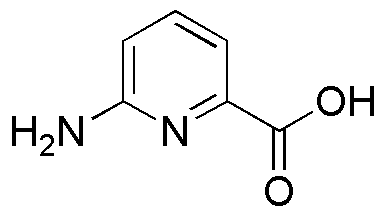6-Aminopyridine-2-carboxylic acid is widely utilized in research focused on:
- Pharmaceutical Development: This compound serves as a key intermediate in the synthesis of various pharmaceuticals, particularly those targeting neurological disorders. Its ability to enhance neurotransmitter function makes it valuable in drug formulation.
- Agricultural Chemicals: It is used in the development of agrochemicals, such as herbicides and fungicides, providing effective solutions for crop protection while minimizing environmental impact.
- Biochemical Research: Researchers employ this compound in studies related to enzyme activity and metabolic pathways, helping to unravel complex biological processes and develop new therapeutic strategies.
- Material Science: Its properties are explored in the creation of novel materials, including polymers and coatings, which can enhance durability and performance in various applications.
- Analytical Chemistry: The compound is
General Information
Properties
Safety and Regulations
Applications
6-Aminopyridine-2-carboxylic acid is widely utilized in research focused on:
- Pharmaceutical Development: This compound serves as a key intermediate in the synthesis of various pharmaceuticals, particularly those targeting neurological disorders. Its ability to enhance neurotransmitter function makes it valuable in drug formulation.
- Agricultural Chemicals: It is used in the development of agrochemicals, such as herbicides and fungicides, providing effective solutions for crop protection while minimizing environmental impact.
- Biochemical Research: Researchers employ this compound in studies related to enzyme activity and metabolic pathways, helping to unravel complex biological processes and develop new therapeutic strategies.
- Material Science: Its properties are explored in the creation of novel materials, including polymers and coatings, which can enhance durability and performance in various applications.
- Analytical Chemistry: The compound is
Documents
Safety Data Sheets (SDS)
The SDS provides comprehensive safety information on handling, storage, and disposal of the product.
Product Specification (PS)
The PS provides a comprehensive breakdown of the product’s properties, including chemical composition, physical state, purity, and storage requirements. It also details acceptable quality ranges and the product's intended applications.
Certificates of Analysis (COA)
Search for Certificates of Analysis (COA) by entering the products Lot Number. Lot and Batch Numbers can be found on a product’s label following the words ‘Lot’ or ‘Batch’.
Número de catálogo
Número de lote/lote
Certificates Of Origin (COO)
This COO confirms the country where the product was manufactured, and also details the materials and components used in it and whether it is derived from natural, synthetic, or other specific sources. This certificate may be required for customs, trade, and regulatory compliance.
Número de catálogo
Número de lote/lote
Safety Data Sheets (SDS)
The SDS provides comprehensive safety information on handling, storage, and disposal of the product.
DownloadProduct Specification (PS)
The PS provides a comprehensive breakdown of the product’s properties, including chemical composition, physical state, purity, and storage requirements. It also details acceptable quality ranges and the product's intended applications.
DownloadCertificates of Analysis (COA)
Search for Certificates of Analysis (COA) by entering the products Lot Number. Lot and Batch Numbers can be found on a product’s label following the words ‘Lot’ or ‘Batch’.
Número de catálogo
Número de lote/lote
Certificates Of Origin (COO)
This COO confirms the country where the product was manufactured, and also details the materials and components used in it and whether it is derived from natural, synthetic, or other specific sources. This certificate may be required for customs, trade, and regulatory compliance.


